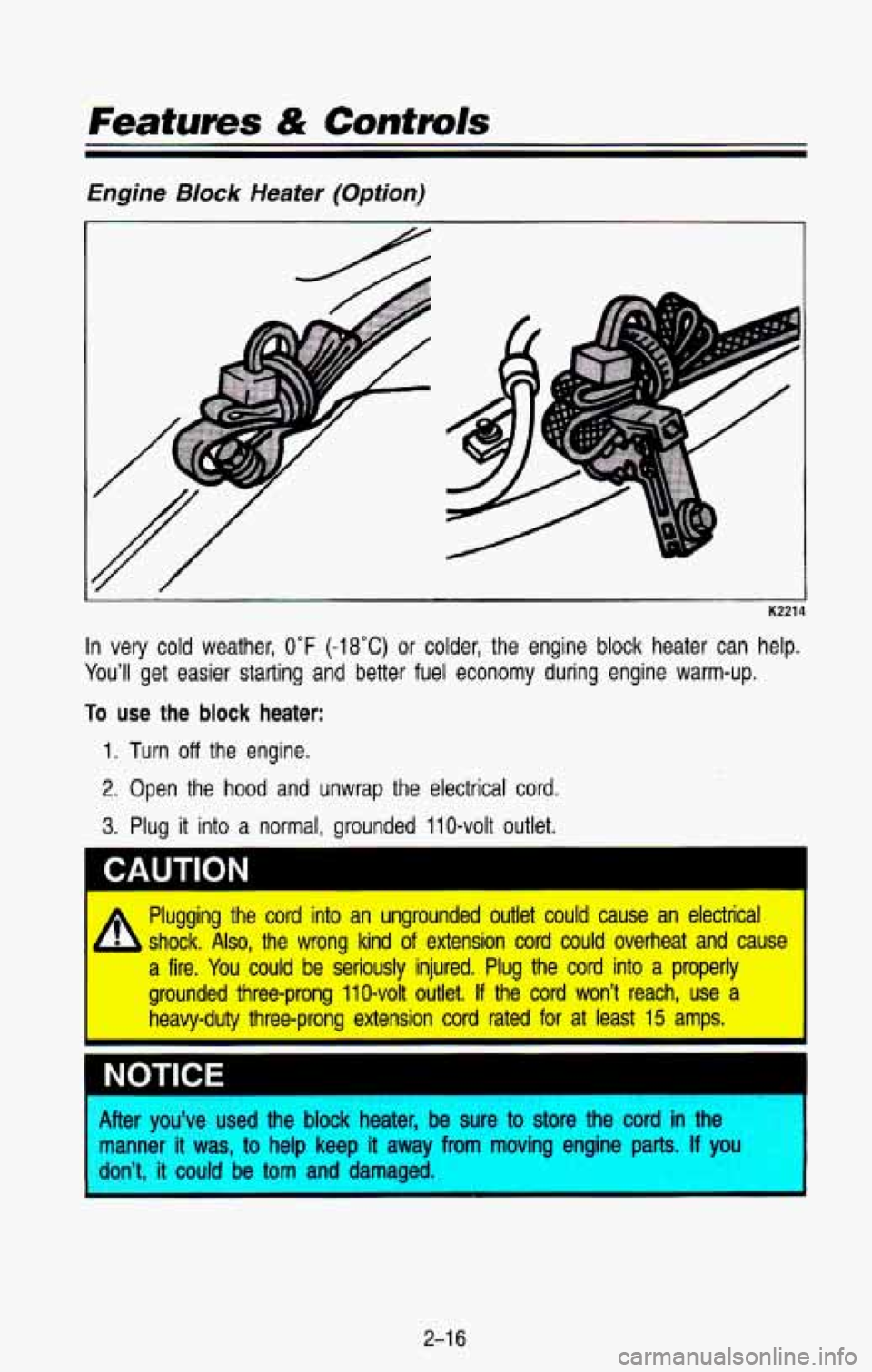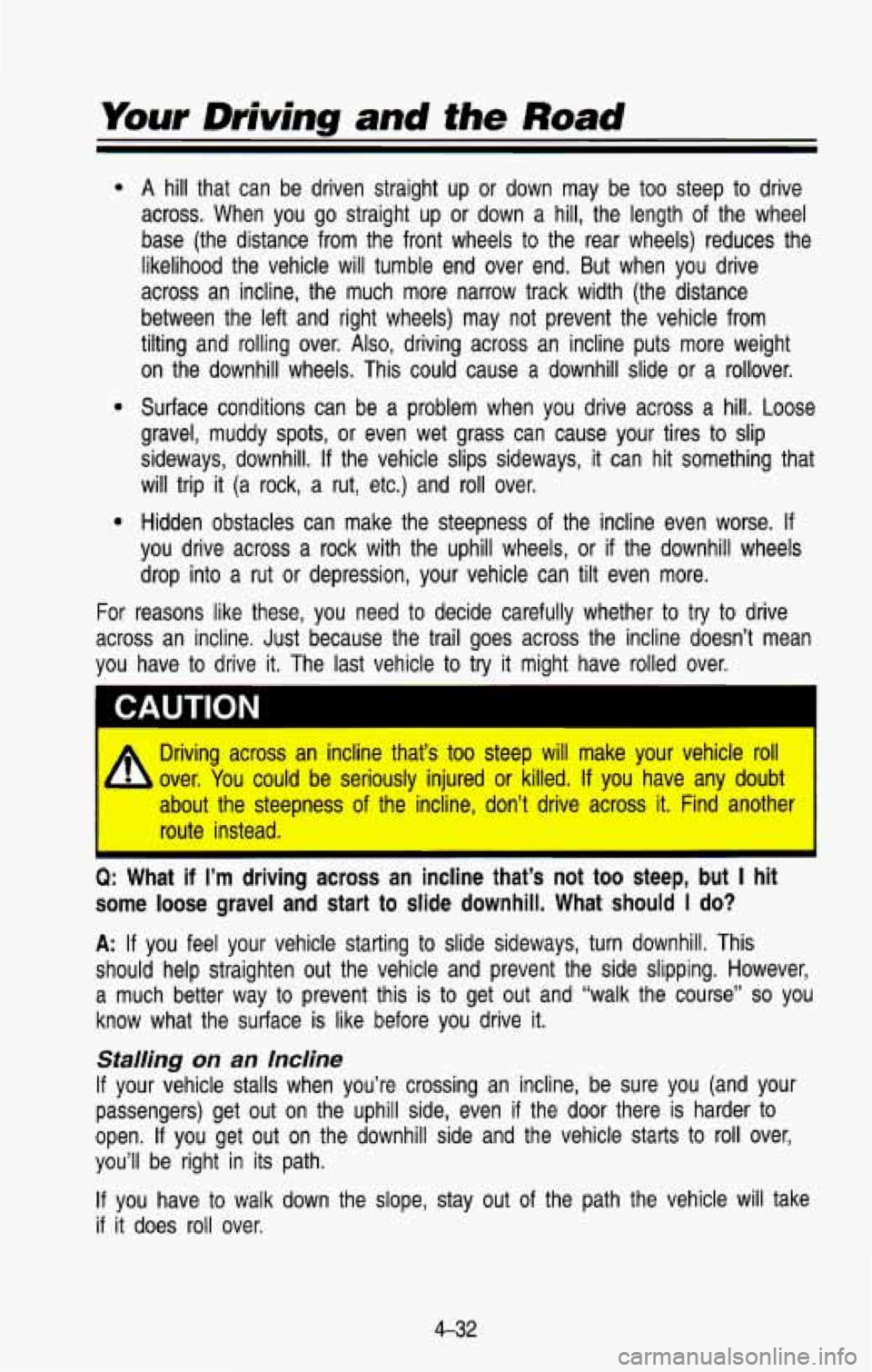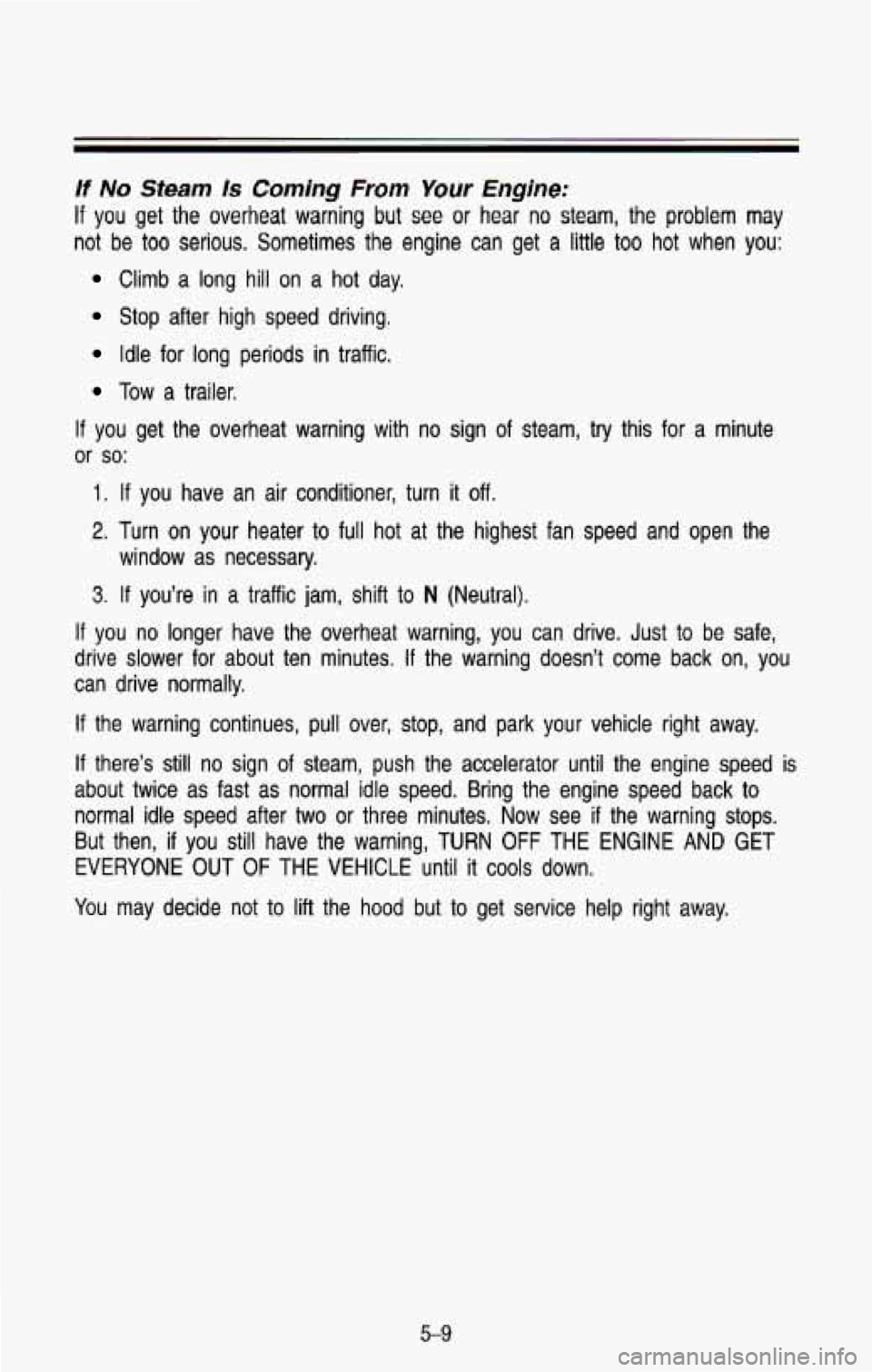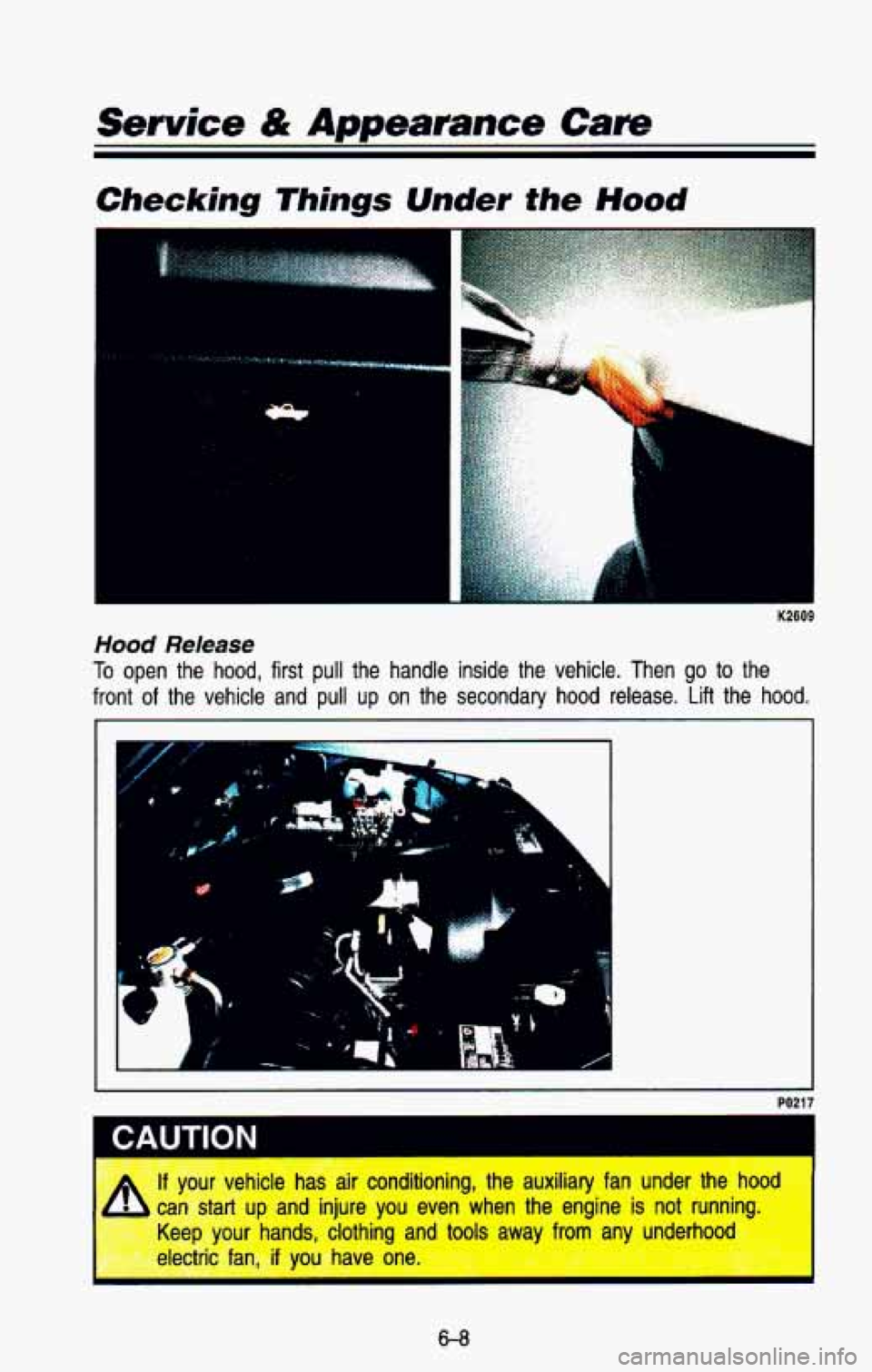1993 CHEVROLET BLAZER open hood
[x] Cancel search: open hoodPage 79 of 386

Features & Controls
Engine BIock Heater (Option)
i K221
In very cold weather, 0°F (-18°C) or colder, the engine block heater can help.
You’ll get easier
starting and better fuel economy during engine warm-up.
To use the block heater:
1. Turn off the engine.
2. Open the hood and unwrap the electrical cord.
3. Plug it into a normal, grounded 110-volt outlet.
I 4
1
Plugging the cord into an ungrounded outlet muld cause an electrical
L shock, Also, the wrong kind of extension cord could overheat and cause
a fire. You could be seriously injured. Plug the cord into a properly
grounded threeprong 110-volt outlet. If the cord won’t reach, use a
heavy-duty threepmng extension cord rated for at least 15 amps.
I
I NOTICE
ter you’ve used the block heater, be sure to store the cord in the
nanner
it was, to help keep it away from moving engine parts. If you
lon’t, it could be tom and damaged.
2-1 6
Page 199 of 386

Your Driving and the Road
0
0
For
A hill that can be driven straight up or down may be too steep to drive
across. When you go straight up or down a hill, the length o\
f the wheel
base (the distance from the front wheels to the rear wheels) reduces the
likelihood the vehicle will tumble end over end. But when you drive
across an incline, the much more narrow track width (the dist\
ance
between the left and right wheels) may not prevent the vehicl\
e from
tilting and rolling over.
Also, driving across an incline puts more weight
on the downhill wheels. This could cause a downhill slide
or a rollover.
Surface conditions can be a problem when you drive across a
hill. Loose
gravel, muddy spots, or even wet grass can cause your tires to slip
sideways, downhill.
If the vehicle slips sideways, it can hit something that
will trip
it (a rock, a rut, etc.) and roll over.
Hidden obstacles can make the steepness
of the incline even worse. If
you drive across a rock with the uphill wheels, or if the do\
wnhill wheels
drop into a rut or depression, your vehicle can tilt even more.
reasons like these, you need to decide carefully whether to try to drive
across an incline. Just because the trail goes across the incline doesn’t mean
you have to drive it. The last vehicle to try it might have rolled over.
CAUTION
A
Driving across an incline that’s too steep will make your vehicle roll
over. You could be seriously injured or killed.
If you have any doubt
about the steepness of the incline, don’t drive across it. \
Find another route instead.
I
Q: What if I’m driving across an incline that’s not too steep, but I hit
some loose gravel and start
to slide downhill. What should I do?
A: If you feel your vehicle starting to slide sideways, turn down\
hill. This
should help straighten out the vehicle and prevent the side sl\
ipping. However, a much better way to prevent this is to get out and “walk the course”
so you
know what the surface is like before you drive
it.
Stalling on an Incline
If your vehicle stalls when you’re crossing an incline, be sure you (and your
passengers) get out on the uphill side, even
if the door there is harder to
open.
If you get out on the downhill side and the vehicle starts to roll over,
you’ll be right in its path.
If you have to walk down the slope, stay out of the path the vehicle will take
if it does roll over.
4-32
Page 235 of 386

ground connection you don’t want. You wouldn’t be able to start your
vehicle, and the bad grounding could damage the electrical systems.
CAUTION
A You could be injured if the vehicles roll. Set the parking brake firmly
on each vehicle. Put an automatic transmission in
P (Park) or a
manual transmission in
N (Neutral).
If you have a four-wheel-drive vehicle, be sure the transfer case is
not in N (Neutral).
3. Turn off the ignition on both vehicles. Turn off all lights that aren’t
needed, and radios. This will avoid sparks and help save both \
batteries.
And it could save your radio!
I
I jou leave a radio on, it could be badly damaged. The repairs woulc
be covered by your warranty.
4. Open the hoods and locate the batteries.
Find the positive
(t) and negative (-) terminals on each battery,
CAUTION
A Using a match near a battery can cause battery gas to explode.
b People have been hurt doing this, and some have been blinded. \
Use
a flashlight if you need more light.
Be sure the batteries have enough water.
You don’t need to add
water
to the Delco Freedom@ battery installed in every new GM
vehicle. But if a battery has filler caps, be sure the right amount of
fluid
is there. If it is low, add water to take care of that first. If you
don’t, explosive gas could be present.
Battery fluid contains acid that can bum you. Don’t get
it on you. If’
you accidentally get it in your eyes or on your skin, flush the place
with water and get medical help immediately. c
5. Check that the jumper cables don’t have loose or missing insulation. If
they do, you could get a shock. The vehicles could be damaged, too.
Before you connect the cables, here are some things you should\
know.
Positive (t) will go to positive (t) and negative (-) will go to negative
5-4
Page 239 of 386

Pmbkms on the Road
If your vehicle has the four-wheel-drive option and the transfer case is
engaged,
a dolly must be used under the rear wheels when towing from the
front.
Engine Overheating
You will find a coolant temperature gage on your vehicle instrument panel,
If Steam Is Coming From Your Engine:
I
‘i Steam from an overheated engine can bum you badly, even if you
just open the hood. Stay away from the engine if you see or hear
steam coming from it. Just turn it off and get everyone away from
the vehide until it cools down. Wait until there is no sign of steam or
coalant before opening the hood.
If you keep driving when your engine is overheated, the liquids in it
can catch fire. You or others could be badly burned. Stop your
engine if it overheats, and get out of the vehicle until the engine is
Cool.
you keep driving with no coolant, your
costly repairs would not be covered
by
your warranty.
5-8
Page 240 of 386

If No Steam Is Coming From Your C gine:
If you get the overheat warning but see or hear no steam, the problem may
not be too serious. Sometimes the engine can get a little too hot when you:
Climb a long hill on a hot day.
Stop after high speed driving.
Idle for long periods in traffic.
Tow a trailer.
If you get the overheat warning with no sign of steam, try this for a minute
or so:
1. If you have an air conditioner, turn it off.
2. Turn on your heater to full hot at the highest fan speed and open the
3. If you’re in a traffic jam, shift to N (Neutral).
window
as necessary.
If you no longer have the overheat warning, you can drive. Just to be safe,
drive slower for about ten minutes.
If the warning doesn’t come back on, you
can drive normally.
If the warning continues, pull over, stop, and park your vehicle right away.
If there’s still no sign of steam, push the accelerator until the engine speed is
about twice as fast as normal idle speed. Bring the engine speed back to
normal idle speed after two or three minutes.
Now see if the warning stops.
But then,
if you still have the warning, TURN OFF THE ENGINE AND GET
EVERYONE
OUT OF THE VEHICLE until it cools down.
You may decide not
to lift the hood but to get service help right away.
5-9
Page 273 of 386

Service & Appearance Care
Checking Things Under the Hood
a&
.. .. .
~
Hood Release
To open the hood, first pull the handle inside the vehicle. Then go to the
front of the vehicle and pull
up on the secondary hood release. Lift the hood.
PO21 7
.. .
CAUTION
A
If your vehicle h;- air conditioning, the auxiliary fan under the hood
,can
start up and injure you even when the engine is not runninc
*y,?*& 8gKeep your hands, clothing and tools awav from anv underhoo
Wk%selectric fan,
you have one
6-8